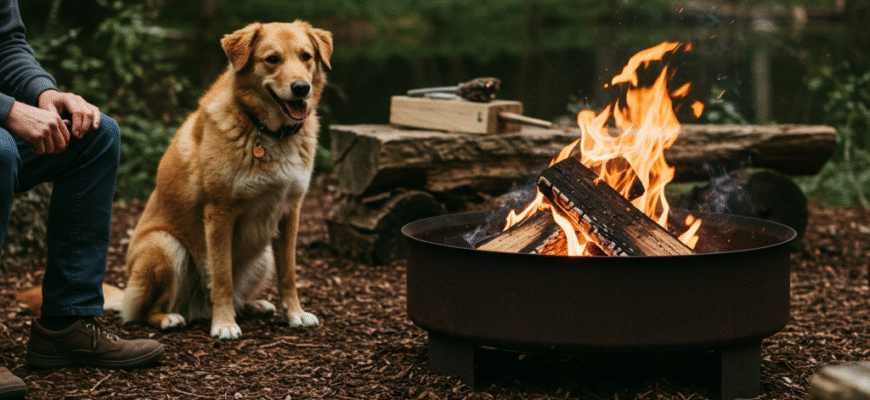Content
Preparing for a Pet-Friendly Fire
Before you even strike a match, setting the stage for safety is paramount. Think about your pet’s individual personality and training. Is your dog generally calm or easily excitable? Does your pet have a reliable recall command, or are they prone to bolting? Understanding their temperament is the first step.Establish a Safe Zone
Creating a designated ‘safe zone’ for your pet, well away from the fire pit, is a smart move. This could be a comfortable blanket, a portable crate (if they are crate-trained and comfortable), or simply an area beside your chair that you consistently guide them back to. The key is distance. A good rule of thumb is to establish a perimeter at least 10 to 15 feet away from the flames and potential sparks. Use camp chairs, coolers, or even temporary pet fencing to create a visual and physical boundary. Reinforce this boundary consistently.Leash and Collar Check
Even if your pet is usually reliable off-leash, the unpredictable nature of a fire (sparks, sudden noises, other people) makes keeping them leashed a crucial safety measure, especially when the fire is active. Ensure their collar or harness fits correctly (snug but not tight – you should be able to fit two fingers underneath) and that the leash is in good condition, free from frays or weak points. A standard 6-foot leash often provides the best balance of freedom and control in this setting. Avoid retractable leashes near a fire, as they offer less immediate control if your pet suddenly lunges.Scout the Area
Before settling in, take a few minutes to walk around the fire pit area. Look for potential hazards that could harm your pet. This includes sharp rocks, broken glass, thorny plants, old fishing hooks if near water, or remnants from previous fires like discarded food scraps or hot embers that weren’t properly extinguished. Clear away anything dangerous.Managing Your Pet During the Bonfire
Once the fire is lit, your supervisory role becomes active. Never leave your pet unattended near a fire, even for a moment. Their curiosity or a sudden scare could lead them dangerously close to the flames or hot surfaces.Constant Supervision is Key
This cannot be stressed enough. Your eyes need to be on your pet frequently. Watch their body language. Are they relaxed, or are they showing signs of anxiety (panting, whining, pacing, ears back)? The noise, smell, light, and heat can be overwhelming for some animals. Be prepared to move them further away or even take them inside or to a quieter spot if they seem distressed.Mind the Heat and Smoke
Pets, especially dogs with shorter snouts (brachycephalic breeds), can be more susceptible to overheating and respiratory issues from smoke. Ensure they have access to plenty of fresh water away from the fire. Position yourselves so that the smoke is blowing away from you and your pet whenever possible. If your pet starts coughing, wheezing, or seems to have difficulty breathing, move them far away from the smoke immediately.Watch for Hidden Heat! Remember that the ground, rocks, and metal surrounding a fire pit can become extremely hot and retain heat long after the visible flames die down. Pets can easily burn their paws on these surfaces. Always check the temperature of the ground before allowing your pet near the extinguished fire area.
Food and Drink Safety
Campfire cooking is often part of the fun, but human food can be hazardous to pets. Keep alcoholic beverages, chocolate, onions, garlic, grapes, raisins, and excessively fatty or salty foods well out of reach. Drippings near the fire can also attract your pet, putting them at risk. Secure all food items and dispose of trash properly in a pet-proof container. Provide your pet with their own safe treats and water bowl away from the main cooking and fire area.Potential Fire-Related Dangers for Pets
Understanding the specific risks helps you anticipate and prevent them.Burns
The most obvious danger. Burns can occur from direct contact with flames, jumping sparks, or hot embers. Even brushing against a hot metal fire ring or stepping on hot coals can cause serious injury. Keeping your pet leashed and maintaining that safe distance is the best prevention.Ingestion Hazards
Curious pets might try to lick or eat things they shouldn’t. Ashes and charcoal can cause gastrointestinal upset or, in larger quantities, blockages. Lighter fluid or fire starters are toxic if ingested. Cooked bones can splinter and cause internal damage. Ensure all such items are inaccessible.Smoke Inhalation
Just like humans, pets can suffer from smoke inhalation. It can irritate their lungs, cause coughing or breathing difficulties, and irritate their eyes. Monitor wind direction and your pet’s reaction to the smoke.Anxiety and Stress
The sensory experience of a bonfire – the crackling sounds, bright flickering light, heat, and smell – can be frightening for some pets, particularly those not accustomed to it. Added people and activity can increase stress. Watch for signs like trembling, hiding, excessive panting, or trying to escape.After the Flames Die Down
Your safety duties don’t end when the party winds down. Proper extinguishment and clean-up are vital.Extinguish Thoroughly
Ensure the fire is completely out. Douse the embers with plenty of water, stir them, and douse again. Repeat until everything is cool to the touch. Buried embers can remain dangerously hot for hours, posing a significant burn risk to pets (and people) who might walk over the area later.Douse, Stir, Feel. The rule for safely extinguishing a campfire is simple but critical. Douse the fire with water, stir the ashes and embers carefully with a shovel, and then feel the area with the back of your hand (hovering first!) to ensure no heat remains. Never bury a fire, as it can smolder underground and reignite.









